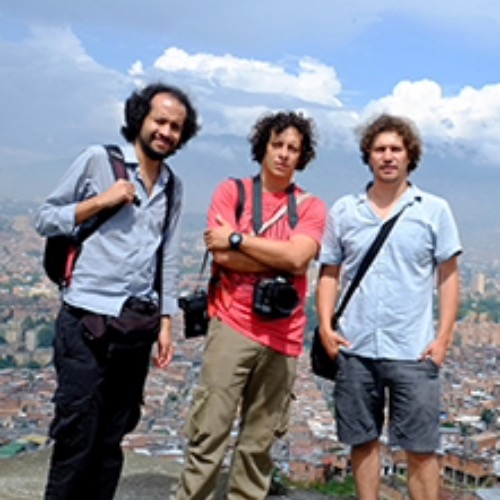- Date
- May 27, 2017
Collective +1
Colombia
The +1 Collective is made up of Colombian photographers Santiago Escobar-Jaramillo, Federico Ríos and Jorge Panchoaga, who have extensive photographic experience, with publications, exhibitions and awards at a national and international level. His interest in living the photographic experience is situated on several fronts: a. Field production; b. Teaching and learning; c. The publication and exhibition of photography; and d. Mutual collaboration. The spirit of the +1 Collective, as its name indicates, is to work in collaboration with other photographers, institutions, organizations and individuals who can add ideas and products on a specific topic. Their joint work has been presented at Casa Tres Patios and MAMM in Medellín, the National University of Colombia and the First Meeting of Fujifilm Visual Narratives in Bogotá, the International Image Festival in Manizales and in the book Fiestas de San Pacho in Quibdó, among others. . Additionally, they are co-founders and curators of @EverydayMacondo on Instagram.- Date
- May 27, 2017
German Eduardo Gomez Uribe
Colombia
Visual designer, Specialist in Aesthetics and Master in Aesthetics and Art History. He has worked as a creative in the area of promotional graphics, alternating with teaching work at the University of Caldas, the Autonomous University of Manizales and in recent years as a full-time teacher of the Graphic Design program at the University of Bogotá Jorge Tadeo Lozano, in which he coordinates the area of promotional graphics and the graphic research hotbed for packaging.- Date
- May 30, 2017
No.otes about experimental film and video-art. A perspective of filmmaking between 'production effects'
Carlos Mauricio Gomez / Colombia
National university of Colombia
akademik.mau@gmail.com
Since the emergence of the seventh art has felt the need to explore even beyond what already 'established' to deepen the characteristics of an emerging new film, away from mercantilist and commercial purpose that this was coming permeating from Hollywood; It is so precisely as theoreticians, artists and experimenters in film managed to come up with other speech, accepted and validated from an audiovisual context. It can be stated that the experimental film and video art has not been made to understand, but from a viewpoint of subjective judgment within a given space and time, is unable to reach a result as such, but the process itself, the ideas they are covering what is observed; thus, an infinite range of views and interpretations is obtained.- Date
- May 30, 2017
Beauty Technology: Seamless interactions through interactive cosmetics
Katia Vega / Peru
UTEC
katia@katiavega.com
Beauty Technology is a novel area of research that presents an exploration between the body surface, beauty products and digital technology. The concept stemmed from a multidisciplinary perspective; computing, chemistry, body anatomy, human behavior, electronics and design. By using Beauty Technologies, we are trying to move away from traditional wearable devices worn on clothes and accessories where gestures for interaction and electronics are noticeable.- Date
- May 30, 2017
The Dermal Abyss: Possibilities of Biosensors as a Tattooed Interface
Katia Cánepa Vega / USA
MIT Media Lab, Harvard Medical School
http://katiavega.com
Advances in biotechnology suggest new use cases outside the domain of research. The Dermal Abyss (d-abyss) is our proposal to create novel biointerfaces within the skin. D-abyss renders an interactive display by patterning into the dermis biosensors whose colors change in response to variations in the interstitial fluid. d-abyss is designed to use the aesthetics, permanence, and visibility nature of tattoos to encode information.- Date
- May 30, 2017
Poietic Strategies in Artistic Practice
Sophie Carolin Wagner / Austria
RIAT – Research Institute for Arts and Technology
scw@riat.at, https://riat.ac.at//
The term poiesis, the basis for the adjective poietic, is derived from Ancient Greek and denotes an act that is directed to create something out of nothing – from poieo (ποιέω): 'to make'; to create something where there was void. Giorgio Agamben calls it in 'The Man with no Content': 'Something passed from nonbeing to being, from concealment into the full light of the work. The essential character of poiesis was not its aspect as a practical and voluntary process but it being a mode of truth understood as unveiling, a-letheia (ἀ-λήθεια).' (Agamben, 1999, p.42) Poiesis stands therefore in opposition to practice, whose end in itself is action: the notion of the will to act. Poiesis on the other hand is not about being a volitional process, but one of revealing and with that a mode of veracity; a possibility for humans to find their own certainties.- Date
- May 30, 2017
Manipulated States of Consciousness: An Artistic Exploration of Perception, Sensation and Immersion
Bonnie Mitchell / USA
Bowling Green State University
http://bonnie-mitchell.com
Bonnie Mitchell's electronic art installations explore the concept of perception and altered emotional states via interactivity, immersion and audio/visual stimuli. Over the past 20 years she has developed a wide range of electronic interactive installations that have altered the participant's sense of reality, time and place.- Date
- May 30, 2017
The Eyes of the Gods
Jane Chang Mi / USA
Honolulu Biennial, Pepperdine University, and UCSB
janecmi@gmail.com
Ancient Hawaiians named the estuary that feeds Pearl Harbor, Wai Momi, or the river of pearls. Oysters (Pinctada radiate) once flourished in the harbor. The shells were used as scrapers to make cloth and rope; they were also carved into fishhooks. The mother of pearl was valued for its iridescence, often used to make the eyes of the gods.
Prev page
123456789101112131415161718192021222324252627282930313233343536373839404142434445464748495051525354555657585960616263646566676869707172737475767778798081828384858687888990919293949596979899100101102103104105106107108109110111112113114115116117118119120121122123124125126127128129130131132133134135136137138139140141142143144145146147148149150151152153154155156157158159160161162163164165166167168169170171172173174175176177178179180181182183184185186187188189190191192193194195196197198199200201202203204205206207208209210211212213214215216217218219220221222223224225226227228229230231232233234235236237238239240241242243244245246247248249250251252253254255256257258259260261262263264265266267268269270271272273274275276277278279280281282283284285286287288289290291292293294295296297298299300301302303304305306307308309310311312313314315316317318319320321322323324325326327328329330331332333334335336337338339340341342343344345
Next page



